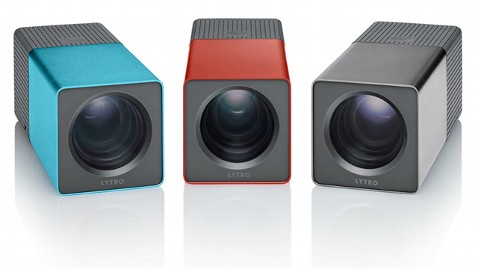Lytro Light-Field Camera: Shoot First, Ask Questions Later
Take at look at the picture that goes with this story. It was taken with a Lytro light-field camera by Kira Wampler of California. If you're a parent, you may think of it as saving one of those priceless moments from your children's early years.
But never mind that - is the little girl in focus? If so, take your cursor (apologies if you're reading this on a platform on which it doesn't work) and click somewhere else in the frame - say, on the boy's face. Now try another spot, perhaps the trees in the background. And another.
We'll wait a minute while you play with it. Everything in the picture can somehow be put in focus, even if things were very different distances from the camera when the shot was taken. Lytro, a California startup company that says it will start selling its camera in February, bills it as a potential game changer.
"I capture expressions on my kids' faces because there's no waiting to shoot," said Wampler, who happens to be Lytro's VP for marketing and demonstrated the camera for us. "I don't miss that half-second when my kids were cute, and then they're not cute anymore, because the camera's trying to focus."
The Lytro camera, unlike conventional cameras, has a matrix of tiny lenses on a sensing chip, gathering light from different sources and directions instead of focusing everything on the same plane as other cameras do. The company's founder, Ren Ng, refined the idea when he was working on his Ph.D. at Stanford.
"The product design is very user-centric. User research shows what folks are having trouble with," said Ng. "We're not doing it for technology's sake, but to make photography simpler, faster and more magical."

The Lytro Light Field camera.
The camera itself looks simple - a small, squared-off tube less than five inches long, with a lens opening at one end and a 1.5-inch LCD touch screen at the other. It weighs about 8 oz. Several people who have seen it have remarked that it reminds them of an old-fashioned kaleidoscope. Embedded in the rubberized grip around the rear end are a shutter release, a slide control for the 8X zoom lens, a small hatch for a mini-USB cord to plug into a computer or power source, and - well, that's about it.
The first camera, Wampler said, will come in just two forms: one with 8 GB of memory (enough for about 350 pictures) for $399, and one with 16 GB (750 pictures) for $499. If you're into accessories, you can buy a fast battery charger and a replacement lens cap.
The market will determine whether the camera is a novelty or the beginning of a revolution. One can imagine there will be a lot of early closeups of flowers with mountains looming in the distance.
Erik Butler, a photography professor at San Francisco's Academy of Art University, said, "The product seems really cool, but might have a short-lived enthusiasm."
Lytro says the camera will be available at first only on its website, and only for computers running Apple's operating system. Later in 2012 there will be software for Windows computers, and eventually the company may license its technology to other camera makers who want to give photographers more creative control.
Most of its power, for now, is in what you do to the images after you've shot them. You could turn them into standard still pictures and print them, but that would be missing their potential, Wampler said. More likely, you'll look at - and play with - them on your computer screen, experimenting with what to highlight. If you email an image to a friend, or embed it in a Facebook page, some software goes with it to let you adjust the focus and perspective.
"What we've seen is that there are two groups who will be interested," said Wampler. "There's one group for whom this might unleash tremendous creative potential - and we can't wait to see what they think of. Creating a story within a picture is a great draw.
"Then there's a second group, which is people like me who just want to get good pictures."
Click HERE for More From the ABC News Gadget Guide.
(ABC News' Laura Riparbelli contributed to this story.)